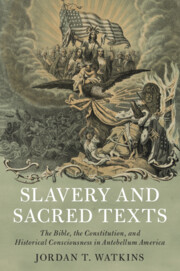 Slavery and Sacred Texts
Slavery and Sacred Texts Published online by Cambridge University Press: 12 June 2021
This chapter focuses on the constitutional debates of the early 1850s, when many antislavery writers narrated both the progress of moral insight, which they viewed as embodied in the rise of antislavery sentiment, and the Slave Power’s advances, which they tracked in the Fugitive Slave Act, fugitive slave cases, and the Kansas-Nebraska Act. In attempts to reconcile their perceptions of both general moral progress and peculiar moral decline, these writers characterized proslavery advances as anachronistic deviations from founding-era expectations and slavery’s unexpected spread as antithetical to the egalitarian spirit of their age. All of this indicated just how different the revolutionary past was from the present, signaling to their contemporaries that it was time to realize the permanent truths that had been enunciated in the transient founding past. In short, antislavery writers promoted a historical consciousness attentive to historical distance: sometimes they narrated the growth of moral opposition to slavery since the founding, and sometimes they narrated the Slave Power’s rise since that time, but in both cases, they pointed to the reality of change over time.
To save this book to your Kindle, first ensure [email protected] is added to your Approved Personal Document E-mail List under your Personal Document Settings on the Manage Your Content and Devices page of your Amazon account. Then enter the ‘name’ part of your Kindle email address below. Find out more about saving to your Kindle.
Note you can select to save to either the @free.kindle.com or @kindle.com variations. ‘@free.kindle.com’ emails are free but can only be saved to your device when it is connected to wi-fi. ‘@kindle.com’ emails can be delivered even when you are not connected to wi-fi, but note that service fees apply.
Find out more about the Kindle Personal Document Service.
To save content items to your account, please confirm that you agree to abide by our usage policies. If this is the first time you use this feature, you will be asked to authorise Cambridge Core to connect with your account. Find out more about saving content to Dropbox.
To save content items to your account, please confirm that you agree to abide by our usage policies. If this is the first time you use this feature, you will be asked to authorise Cambridge Core to connect with your account. Find out more about saving content to Google Drive.